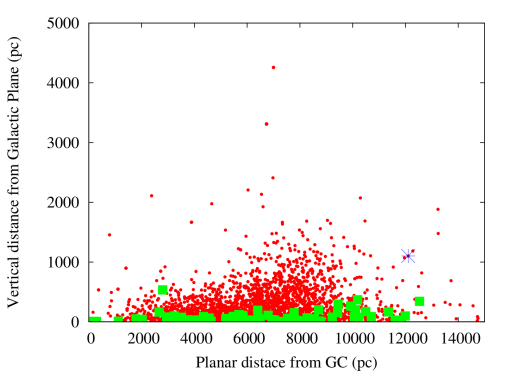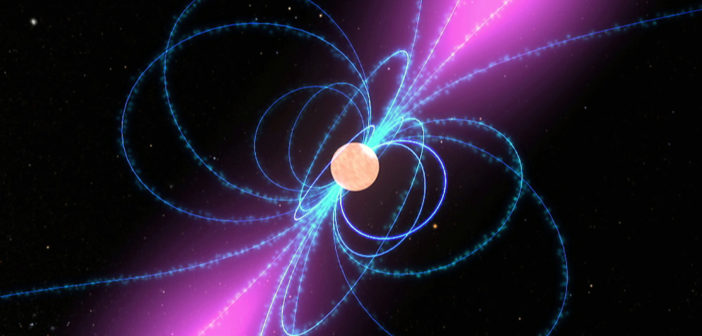Editor’s note: Astrobites is a graduate-student-run organization that digests astrophysical literature for undergraduate students. As part of the partnership between the AAS and astrobites, we occasionally repost astrobites content here at AAS Nova. We hope you enjoy this post from astrobites; the original can be viewed at astrobites.org.
Title: The Location of Young Pulsar PSR J0837−2454: Galactic Halo or Local Supernova Remnant?
Authors: Nihan Pol et al.
First Author’s Institution: West Virginia University; Vanderbilt University
Status: Published in ApJ
In 1967, a graduate student named Jocelyn Bell Burnell discovered the first pulsar, opening a window into a universe teeming with many wild and wonderful varieties of these extreme objects. Pulsars are fast-spinning neutron stars with powerful magnetic fields, emitting beams of radio waves. They give rise to many interesting phenomena: some pulsars cannibalize companion stars, others emit pulses of high-energy gamma rays, and still others exhibit sudden changes in their rotation period.
Despite this diversity, pulsar astronomers have managed to establish some typical properties of pulsars. For example, pulsars — especially very young pulsars — are rarely found far from the plane of the Milky Way. The stars that form them usually live in the galactic disk, and many pulsars simply don’t have enough time to move away. Today’s paper, however, focuses on a pulsar that seems to be much farther from the galactic plane than we should expect. What could be going on?
The Paradoxical Pulsar
This particular pulsar, designated J0837–2454, was discovered in 2011 using the Parkes Radio Telescope. However, it took six more years to produce enough data to adequately constrain its properties. The authors found that the pulsar was young, estimating its age to be a mere 28,600 years, with a reasonable rotation period and magnetic field. What made it stand out like a sore thumb was its dispersion measure, or DM. The dispersion measure describes how many free electrons lie between us and the pulsar, so it acts as a sort of distance proxy: if you know the DM, the location of the pulsar in the sky, and how the galaxy’s electrons are distributed, you can calculate its distance from us.
The astronomers picked two widely used models of the Milky Way’s electron density, derived from, among other things, measurements of dispersion measures and distances to known pulsars. One, the NE2001 model, predicted that J0837–2454 should lie 6.3 kpc (a bit over 20,000 light-years) from Earth, placing it a whopping 1.1 kpc above the galactic plane — much higher than any pulsar of comparable age. The other, the YMW model, predicted that it should lie beyond the galactic disk. Both would be a surprising result, so the authors considered other means of estimating the distance to the pulsar.

Figure 1: Most pulsars (shown in red) lie close to the galactic plane, and previously known pulsars less than 50,000 years old (in green) tend to be even closer. According to a standard model of the Milky Way’s electron distribution, PSR J0837-2454 (marked with a blue asterisk) appears to lie at least twice as far away as any other known pulsar of comparable age. [Pol et al. 2021]
Getting a Second Opinion — and a Third
Many young pulsars are associated with supernova remnants (SNRs), so it made sense to see if there was one near J0837–2454. The group used the Australia Telescope Compact Array (ATCA) to search for radio emission from a remnant, supplementing their observations with archival images from the radio Galactic and Extra-galactic All-sky MWA Survey (GLEAM) and the Southern Hα Sky Survey (SHASSA).
The ATCA observations were unable to detect any SNR-like emission, but the GLEAM images showed a faint structure near the pulsar, which might represent an SNR. Assuming this is actually an SNR associated with the pulsar, this structure could provide an independent estimate of the distance to J0837-2454: models of SNR evolution could estimate its physical size and compare that to its angular size, thus yielding the distance to the source. Using this method, the authors found a distance of only 0.9 kpc from Earth, placing the structure — and the pulsar, if the structure is, indeed, an associated SNR — at a more reasonable offset from the plane.

Figure 2: Stacked images from the Galactic and Extra-galactic All-sky MWA Survey (GLEAM) show an excess of radio emission in a round region overlapping with PSR J0837–2454, marked by a red cross. This excess has been interpreted as a possible supernova remnant associated with the pulsar. A second nearby pulsar, PSR J0838–2621, is marked by a purple cross and is believed to be unassociated with the pulsar and the candidate supernova remnant. [Pol et al. 2021]
Tying Up Loose Ends
There are still several issues to consider. Assuming the distance derived from the NE2001 model is correct, how could the pulsar have traveled so far from the disk? To have traveled 1.1 kpc in 28,600 years would require the pulsar to be moving unreasonably fast. However, this rests on the assumption that the pulsar was born within the disk; it’s possible that it actually formed much closer to its present position. The massive progenitor could have been a runaway star, propelled away by a companion star going supernova. One way of confirming or refuting this scenario would be to measure the velocity of the pulsar out of the plane — not an easy task, but not impossible.
This still leaves an obvious problem: if NE2001 distance estimate is correct, why didn’t ATCA detect a supernova remnant? It’s possible that the structure detected by GLEAM is completely unrelated to the pulsar, and that the real SNR is simply too faint. If the circumstellar medium around the pulsar is too diffuse, or the magnetic field is too weak, the remnant would be unable to generate strong enough synchrotron emission at radio frequencies for it to be detectable by ATCA. A combination of the two seems to be a feasible explanation. As next-generation radio telescopes like the Square Kilometre Array come online, maybe we can find the final pieces of this pulsar puzzle.
Author’s note: While Nihan Pol, Sarah Burke-Spolaor and Harsha Blumer are or have been part of my department, I was not involved with this research.
Original astrobite edited by Sabina Sagynbayeva.
About the author, Graham Doskoch:
I’m a first-year graduate student at West Virginia University, pursuing a PhD in radio astronomy. My focus is on neutron stars and pulsar timing, a method of detecting gravitational waves by monitoring arrays of pulsars over the course of many years. I’m an associate member of NANOGrav, and I’m starting to help with their ongoing timing efforts. I love running, hiking, reading, and just enjoying nature.

